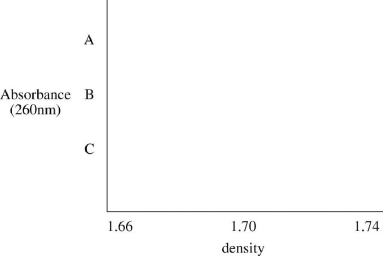Essay
Assume that you grew a culture of E. coli for many generations in medium containing 15N (from the ammonium ion), a heavy isotope of nitrogen. You extract DNA from a portion of the culture and determine its density to be 1.723 gm/cm3 (call this sample
A). You then wash the remaining E. coli cells and grow them for one generation in 14N, extract the DNA from a portion of the culture, and determine its density to be 1.715 gm/cm3 (call this sample
B). You let the culture grow for one more generation in 14N, and extract the DNA (call this sample
C) is then heated to completely denature the double-stranded structures, cooled quickly (to keep the strands separate), and subjected to ultracentrifugation. Present the centrifugation profiles for heat-denatured DNA (samples A, B, and
C) that you would expect. Use the graph below. (Note: Although not the case, assume that single-stranded DNA has the same density as double-stranded DNA.)

C). Each sample of DNA (A, B, and
Correct Answer:

Verified
Correct Answer:
Verified
Q5: A nucleosome is a structure associated with
Q9: Given that the origin of replication is
Q10: Assume that you grew a culture of
Q14: Refer to the accompanying diagram of a
Q16: DNA replication in vivo requires a primer
Q16: The discontinuous aspect of replication of DNA
Q17: Telomerase is an RNA-containing enzyme that adds
Q26: During DNA replication,what is the function of
Q38: Given that the nature of DNA replication
Q41: What term is used to describe genetic